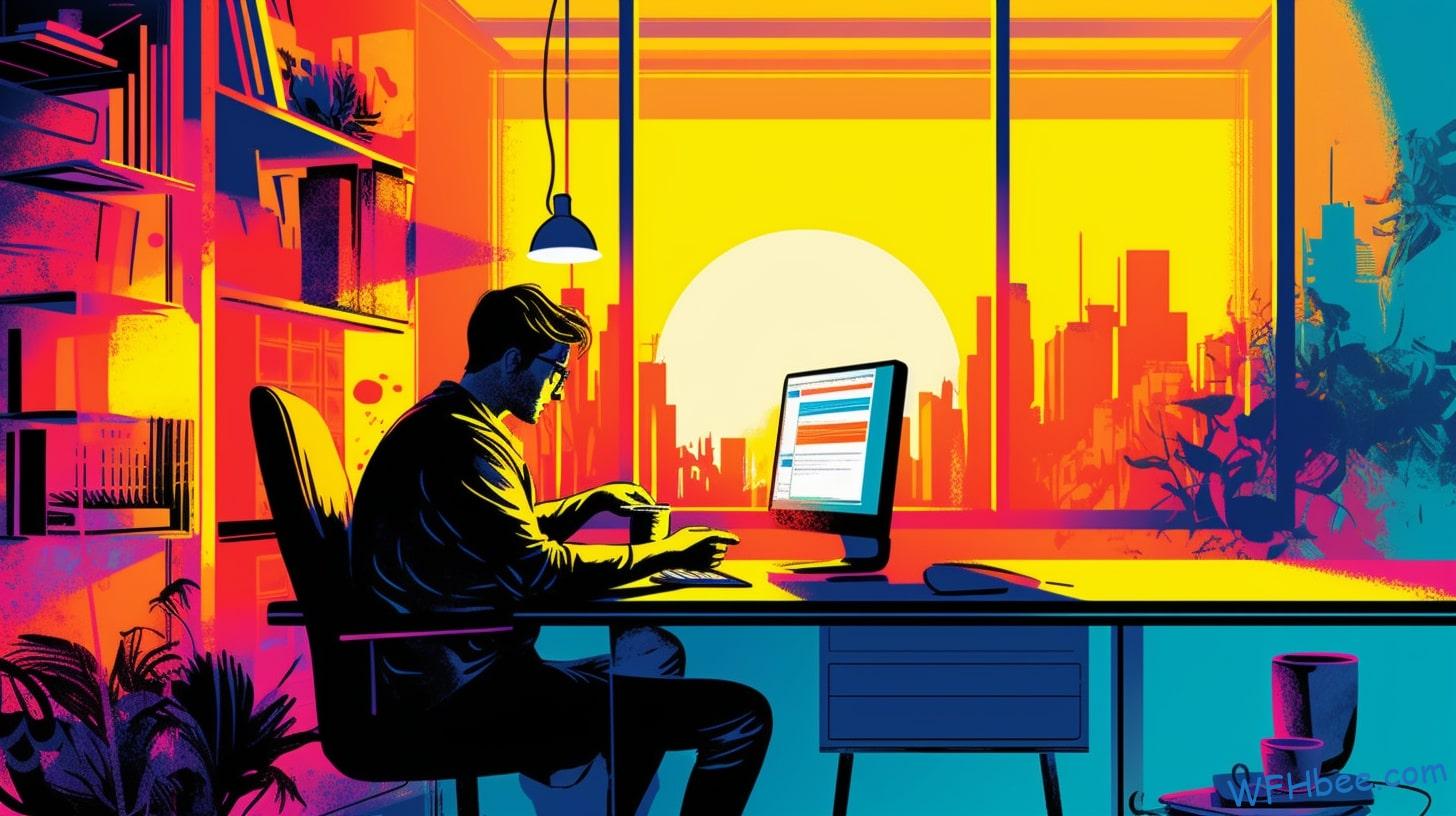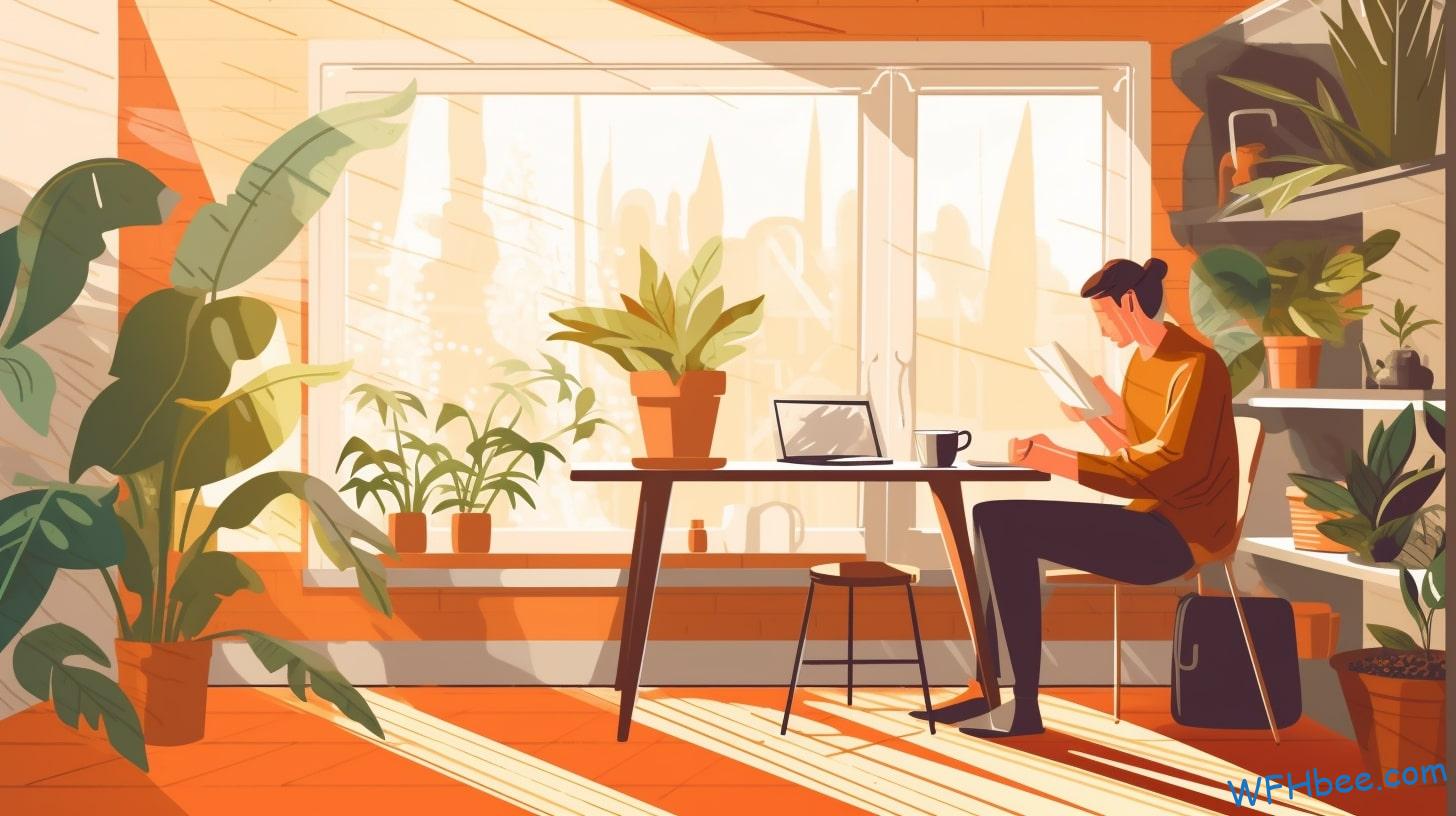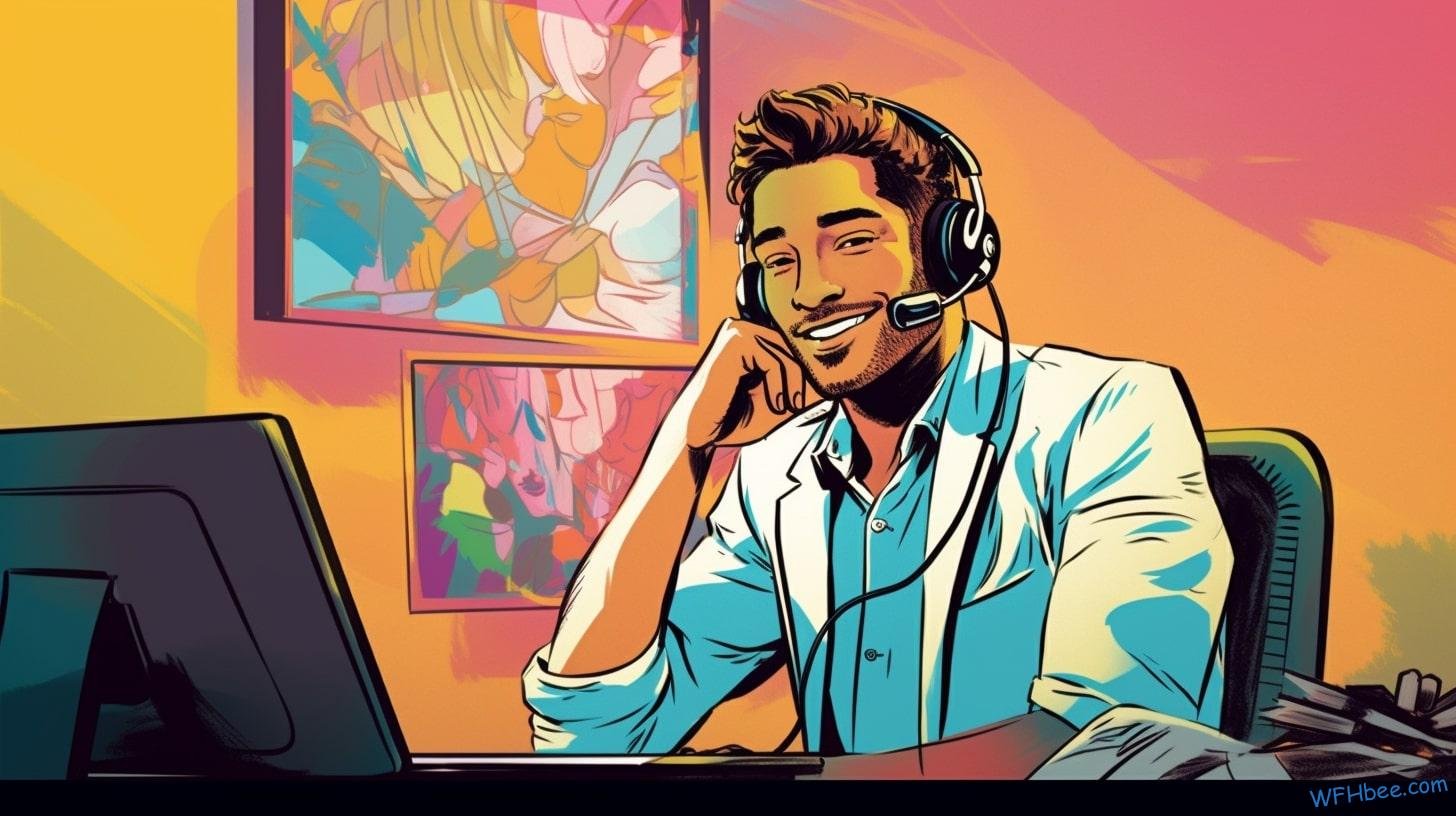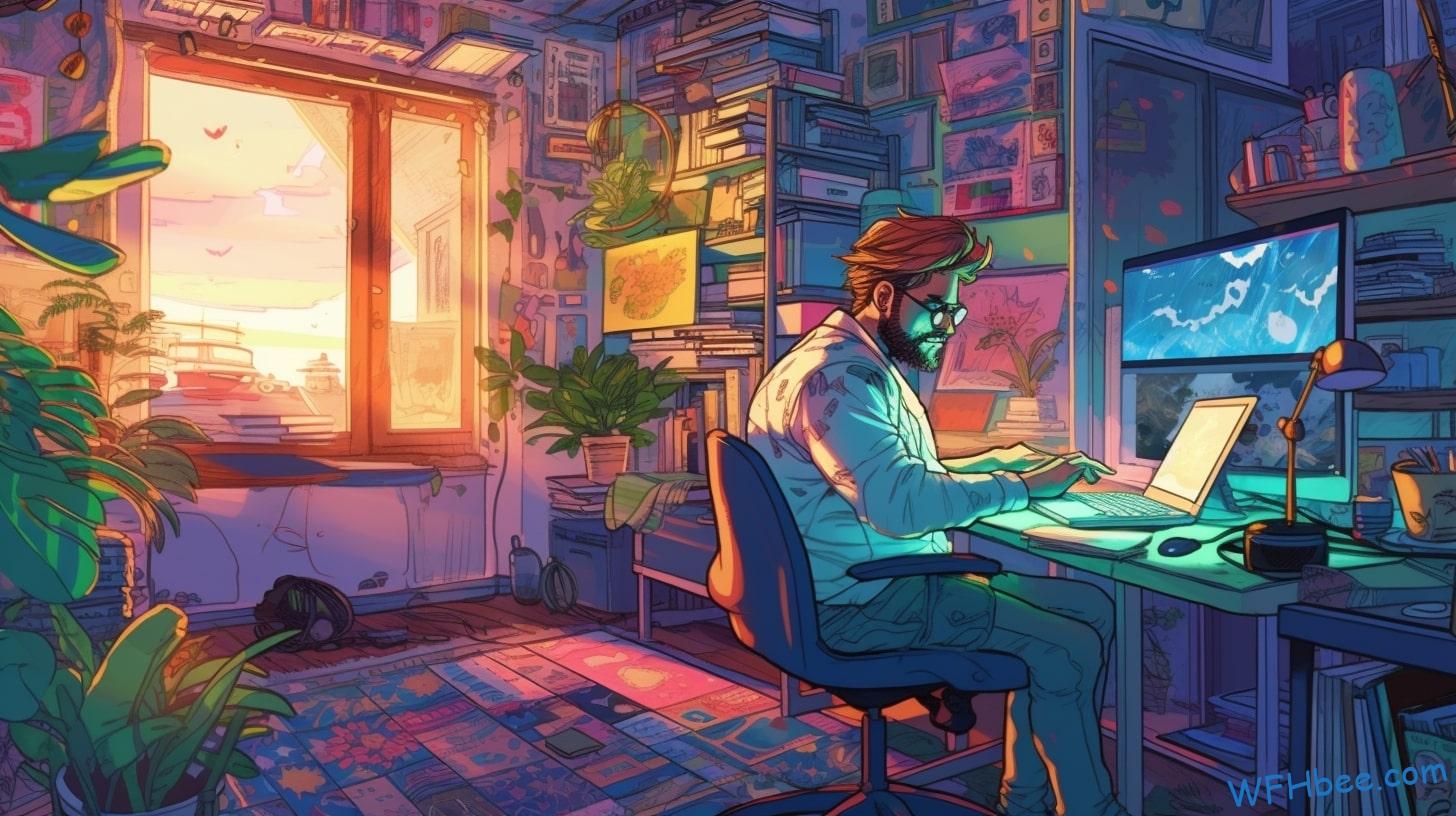Looking to break free from the confines of the traditional office space? Well, buckle up because remote work is here to set you free!
In this article, we’ll explore the world of remote work for web designers and all the amazing benefits it brings.
From the essential skills you need to thrive in a remote setting to the tools and software that will make your life easier, we’ve got you covered.
So get ready to embrace freedom as a remote web designer and take control of your career.

Table of Contents

Benefits of Remote Work for Web Designers
There’s a multitude of benefits for web designers when it comes to remote work. If you desire freedom and flexibility in your work, remote work is the perfect fit for you. One of the major advantages of remote work is the flexibility it offers. You have the freedom to choose your own schedule and work at your own pace. No more rigid 9-to-5 hours or commuting in rush hour traffic. With remote work, you can design websites from anywhere in the world as long as you have a stable internet connection.
Remote work also allows for a better work-life balance. Gone are the days of sacrificing personal time for work commitments. As a web designer working remotely, you can allocate time for family, hobbies, and self-care without compromising on your professional responsibilities. This increased flexibility enables you to lead a more fulfilling life outside of work.
In addition to flexibility and work-life balance, remote work provides numerous other benefits for web designers. For example, working remotely eliminates office distractions and allows you to create an optimal working environment tailored to your needs. Whether that means blasting your favorite tunes or designing in complete silence, it’s entirely up to you.
Furthermore, remote work opens up opportunities for collaboration with clients from all over the world. You’re not limited by geographical boundaries anymore; instead, you can tap into a global network of clients and projects.

Essential Skills for Remote Web Designers
To excel in your role as a remote web designer, it’s crucial to develop essential skills that will set you apart from others. Working remotely offers you the freedom and flexibility to design websites from anywhere in the world. Here are four essential skills that will help you thrive in this remote work environment:
- Adaptability: As a remote web designer, you need to be adaptable to different working conditions and time zones. Embrace change and be open to new technologies and trends in the industry.
- Self-discipline: Working remotely requires self-discipline and strong time management skills. Without a physical office or colleagues around, it’s easy to get distracted or procrastinate. Stay focused on your tasks and set clear deadlines for yourself.
- Communication: Effective communication is key when working remotely. You’ll need excellent written and verbal communication skills to collaborate with clients, team members, and stakeholders who may be located in different parts of the world.
- Problem-solving: Remote web designers often encounter technical challenges while working on projects independently. Being resourceful and having strong problem-solving abilities will enable you to overcome obstacles efficiently.
By honing these essential skills for remote work, you’ll position yourself as a highly sought-after web designer who can deliver quality results regardless of location or working conditions.
Embrace the freedom that comes with remote work, stay motivated, and continue learning to stay ahead in this ever-evolving industry.

Tools and Software for Remote Web Designers
Make sure you have the necessary tools and software to maximize your productivity as a remote web designer. As someone who desires freedom in your work, it’s essential to have the right resources at your disposal.
Remote collaboration tools play a crucial role in facilitating efficient communication and teamwork with clients and colleagues.
To streamline your remote design workflow, consider using project management platforms like Trello or Asana. These tools allow you to create tasks, set deadlines, and collaborate with others seamlessly. Additionally, utilizing cloud storage services such as Google Drive or Dropbox will enable you to access files from anywhere, ensuring that you can work on projects even when away from your desk.
When it comes to design software, Adobe Creative Cloud is an industry standard for web designers. With programs like Photoshop and Illustrator, you can create stunning visuals and manipulate graphics effortlessly. Furthermore, prototyping tools like Sketch or Figma will help bring your designs to life by allowing you to create interactive mockups of websites or apps.
Effective communication is vital for successful remote collaborations. Tools like Slack or Microsoft Teams offer chat functionality for quick discussions and file sharing capabilities for seamless collaboration with team members. Video conferencing platforms such as Zoom or Google Meet are great options for virtual meetings where face-to-face interactions are needed.

Overcoming Challenges as a Remote Web Designer
Overcoming challenges as a remote designer can be a rewarding and transformative experience. As you navigate this freedom-filled journey, you may encounter distractions that threaten to derail your productivity and work-life balance. But fear not! With the right mindset and strategies in place, you can conquer these challenges and thrive in your remote design career.
Here are four ways to overcome distractions and maintain a healthy work-life balance:
- Set boundaries: Establish clear boundaries between your work and personal life. Create designated workspaces and establish set working hours to minimize distractions and maintain focus.
- Practice mindful time management: Prioritize tasks, break them down into manageable chunks, and allocate specific time slots for each task. This will help you stay organized, focused, and prevent overwhelm.
- Minimize interruptions: Communicate with family members or roommates about your working schedule so they understand when you need uninterrupted time to concentrate on your design projects.
- Embrace self-care: Take breaks throughout the day to relax, recharge, and avoid burnout. Engage in activities that bring you joy or help you unwind such as going for walks, practicing meditation or yoga, or indulging in hobbies outside of work.
By implementing these strategies into your remote design routine, you’ll have the freedom to create incredible designs while maintaining a healthy work-life balance.
Remember that overcoming distractions is an ongoing process – be patient with yourself as you navigate this new way of working. Stay focused, stay determined, and embrace the rewards that come with being a remote designer!

Tips for Effective Communication in Remote Web Design Teams
When collaborating in a remote team, it’s essential to maintain open and clear communication channels with your fellow designers. Effective communication techniques play a crucial role in ensuring efficient remote team dynamics. In this freedom-seeking world of remote work, you have the power to shape your own interactions and foster a strong sense of collaboration.
To enhance communication within your remote web design team, start by establishing regular check-ins. Schedule weekly video conferences or use messaging platforms to touch base with your colleagues. By doing so, you can stay updated on project progress, address any concerns promptly, and strengthen trust among team members.
Another effective technique is to utilize collaborative tools that facilitate real-time communication and document sharing. Platforms like Slack or Trello allow for seamless collaboration by providing shared spaces where you can discuss ideas, share feedback, and assign tasks. These tools not only streamline workflows but also foster transparency and accountability.
Additionally, when communicating remotely, it’s important to be concise yet comprehensive in your messages. Use clear language and avoid ambiguity to ensure everyone understands the information being conveyed. Remember that written communication lacks the non-verbal cues present in face-to-face conversations; therefore, be mindful of tone and intent when crafting messages.
Lastly, encourage an open-door policy within your remote team where everyone feels comfortable expressing their thoughts or seeking clarification. Actively listen to others’ perspectives and provide constructive feedback when needed. This inclusive approach fosters a sense of belongingness and strengthens relationships among team members.

Creating a Productive Remote Work Environment for Web Designers
To maximize productivity in your remote setup, it’s important to establish a dedicated workspace that promotes focus and minimizes distractions. Here are some tips to help you create a comfortable workspace and manage your time effectively:
- Designate a specific area: Set aside a designated space in your home for work. This will help you mentally separate work from leisure and create a sense of structure.
- Choose ergonomic furniture: Invest in a comfortable chair and desk that support good posture and prevent discomfort or strain on your body. Your physical comfort is essential for long hours of focused work.
- Organize your tools: Keep all necessary tools, such as your computer, notebooks, pens, and other supplies, within arm’s reach. Having everything organized will save you time searching for items during the day.
- Eliminate distractions: Minimize noise by using headphones or playing soothing background music if it helps you concentrate better. Also, consider using apps or browser extensions to block distracting websites during work hours.
By creating an environment that allows you to focus without interruptions, you can enhance your productivity as a web designer working remotely.
Additionally, managing your time effectively is crucial when working independently:
- Prioritize tasks: Make a to-do list each day with the most important tasks at the top. Focus on completing high-priority items first.
- Set boundaries: Establish clear boundaries between work and personal life to avoid burnout. Define specific working hours and stick to them.
- Take breaks: Schedule short breaks throughout the day to rest and recharge mentally. Stepping away from your workstation can actually improve productivity when you return.
- Stay organized: Use digital calendars or project management tools to stay on top of deadlines and track progress on different projects.
Creating a productive remote work environment involves finding balance between comfort and efficiency while managing time effectively – allowing freedom in both creativity and lifestyle choices as a web designer.

Finding Remote Web Design Opportunities
If you’re looking for opportunities in the field of web design that allow you to work remotely, networking with other professionals in the industry can be a valuable way to uncover potential job leads.
In today’s digital age, there are numerous remote web design job boards and online communities where you can connect with like-minded individuals who share your passion for designing websites from anywhere in the world.
By joining these remote web design job boards and actively participating in discussions, you can gain insider knowledge about available job openings and freelance gigs. Networking with other remote web designers also allows you to tap into their connections and potentially find hidden opportunities that may not be advertised elsewhere.
In addition to job boards, social media platforms such as LinkedIn and Twitter can be powerful tools for networking with professionals in the industry. Building relationships with fellow web designers through these platforms can lead to referrals and introductions to potential clients or employers.
Attending industry conferences or meetups is another effective way to network with remote web designers. These events provide opportunities for face-to-face interactions and meaningful conversations that can open doors to exciting projects or collaborations.
Remember, networking is all about building genuine relationships based on trust and mutual interests. Be proactive in reaching out to others, offering assistance when possible, and staying connected even after initial interactions.

Balancing Work and Life as a Remote Web Designer
Now that you’ve found remote web design opportunities, it’s important to focus on balancing your work and life as a remote web designer. While working remotely offers freedom and flexibility, it also presents challenges that can affect your work-life balance. Here are some tips to help you maintain a healthy equilibrium:
- Establish boundaries: Set clear boundaries between work and personal life. Define specific working hours and stick to them. Avoid the temptation to work beyond those hours unless absolutely necessary.
- Create a dedicated workspace: Designate a specific area in your home for work. This will help you mentally separate your professional and personal space, allowing for better focus during working hours.
- Take regular breaks: Remember to take breaks throughout the day to refresh your mind and prevent burnout. Step away from your desk, stretch, or engage in activities that bring you joy.
- Stay connected with others: Working remotely can sometimes be isolating, so make an effort to stay connected with colleagues and friends through virtual meetings or social media platforms.
Balancing work and life as a remote web designer is essential for maintaining productivity while enjoying the freedom of remote work. By implementing these tips, you’ll create a healthier work environment where you can thrive both professionally and personally.

Remote Collaboration Strategies for Web Design Projects
Establishing clear communication channels and utilizing collaborative tools are crucial for successful teamwork in web design projects.
As a remote web designer, you have the freedom to work from anywhere, but it’s important to stay connected with your team members and clients. Remote design collaboration allows you to share ideas, receive feedback, and make necessary changes efficiently.
One effective strategy for remote design collaboration is using online platforms that enable real-time communication. Tools like Slack or Microsoft Teams provide chat features where you can discuss project details, ask questions, and share updates instantly. These platforms also allow you to create separate channels for different topics or teams, ensuring that everyone is on the same page.
Another essential aspect of remote collaboration is receiving feedback on your designs. While it may be challenging not being physically present with your team or clients, there are numerous ways to overcome this obstacle. You can use screen sharing tools like Zoom or Google Meet to present your designs in real-time while receiving live feedback from stakeholders.
Additionally, utilizing design collaboration tools such as Figma or InVision enables seamless sharing and commenting on design files. These platforms allow multiple users to collaborate simultaneously by making edits directly on the interface or leaving comments for specific elements.
Remember that clear communication channels and collaborative tools are essential for successful remote design projects. By incorporating these strategies into your workflow, you can foster effective teamwork and produce high-quality web designs regardless of physical distance.

Staying Motivated and Productive as a Remote Web Designer
Staying motivated and productive as a remote web designer can be challenging, but implementing strategies such as setting clear goals and creating a structured routine can help maintain focus and achieve success. As someone who craves freedom in their work life, it’s essential to find ways to stay focused and maintain a healthy work-life balance.
Here are four tips to help you on your journey:
- Prioritize your tasks: Start each day by identifying the most important tasks that need to be completed. By focusing on these key priorities, you can ensure that you make progress on projects that truly matter.
- Create a dedicated workspace: Designate an area in your home specifically for work. This will help create a clear separation between your personal and professional life, allowing you to fully immerse yourself in your work when needed.
- Take regular breaks: It’s easy to lose track of time when working remotely, so make it a point to take regular breaks throughout the day. Step away from your computer, stretch or go for a short walk outside. These mini-breaks will refresh your mind and prevent burnout.
- Set boundaries: Establishing clear boundaries between work hours and personal time is crucial for maintaining work-life balance. Communicate with clients or colleagues about your availability and stick to those designated hours whenever possible.

Frequently Asked Questions
How Can Remote Work Benefit Web Designers in Terms of Work-Life Balance?
You can achieve a better work-life balance by exploring remote work opportunities. Without the confines of an office, you have the freedom to design your schedule and prioritize personal time while still delivering high-quality web design projects.
What Are Some Common Challenges That Remote Web Designers Face and How Can They Overcome Them?
Overcoming challenges when working remotely as a web designer can be tough, but don’t worry! With determination and resourcefulness, you can conquer any obstacle that comes your way. Embrace the freedom remote work offers and thrive!
What Are Some Essential Communication Skills for Remote Web Designers to Effectively Collaborate With Their Team?
To effectively collaborate with your team, you need essential communication skills like active listening and clear, concise expression. Utilize collaboration techniques such as regular check-ins and virtual meetings to foster effective communication strategies.
Are There Any Specific Tools or Software That Remote Web Designers Should Use to Enhance Their Productivity?
To enhance your productivity as a remote web designer, consider using productivity tools and software recommendations. These resources can help you streamline your workflow and accomplish tasks more efficiently, giving you the freedom to work remotely with ease.
How Can Remote Web Designers Find Opportunities for Remote Work in the Web Design Industry?
To find opportunities for remote work in the web design industry, explore remote job boards and attend networking events. Picture yourself as a freedom seeker, navigating through a sea of possibilities to land your dream remote gig.

Conclusion
Congratulations! You’ve reached the end of this article on remote work for web designers.
Now that you have gained insights into the benefits, essential skills, tools, and challenges of working remotely as a web designer, it’s time to put your knowledge into action.
Remember to communicate effectively, find opportunities that align with your goals, maintain a healthy work-life balance, collaborate efficiently, and stay motivated.
With these strategies in place, you’ll be able to thrive as a remote web designer and create amazing digital experiences from anywhere in the world.
So go ahead and let your creativity soar!







